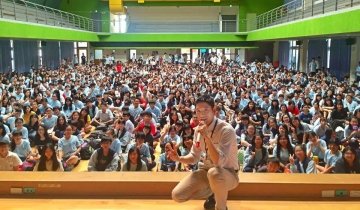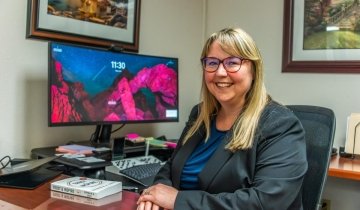Amanda Holdsworth EdD ’17 first stepped onto a college campus in Windsor, Ontario, when she was just 5 years old. Her mother, pursuing a psychology degree and faced with a lack of child care options when Holdsworth’s first snow day came around, had no choice but to bring the kindergartner to class.
Windsor averages more than 50 inches of snowfall a year, so Holdsworth attended class with her mother a few times, an experience she describes as “magical.” She was even, on occasion, a tool for instruction, once brought to the front of the lecture hall during a child psychology course and asked to draw pictures for the class to analyze.
When Holdsworth attended high school, Ontario schools included a grade 13 that prepared students for postsecondary education. Holdsworth already knew she wanted to do something in communications. And she also knew she wanted to see the world.
Her father, a first-generation Canadian, had roots in Eastern Europe, so when she began looking into study abroad programs for her final year of high school, Russia topped her list. However, given the country’s economic and political upheaval at that time, Holdsworth settled on New Zealand, enrolling at Sir Edmund Hillary Outdoor Pursuits Centre. When it came time for college, Holdsworth, an accomplished athlete in tennis and soccer, was recruited by several U.S. universities. She landed at Robert Morris University in Pittsburgh, Pennsylvania, where she played Division I tennis and studied communications management. Holdsworth also continued to see the world, studying abroad in the Czech Republic before enrolling at USC.
Holdsworth’s first degree at USC was a master’s in strategic public relations from the Annenberg School for Communication and Journalism, where she served as a graduate assistant for the International Communications Studies program, overseeing a class that travels to London, Paris, Prague and Geneva.
Her 20-year career has spanned K–12 schools and universities. But even as she reached great heights—earning 24 industry awards and speaking at conferences around the world—Holdsworth felt the pull of the classroom. She knew that in order to take on larger-scale market research projects within schools and districts, she needed the credentials. With a doctorate in education, Holdsworth felt she would be equipped to “talk the talk.”
Already balancing a full-time job with raising two small children, Holdsworth needed flexibility. USC Rossier’s online EdD in Organizational Change and Leadership checked all the boxes, and Holdsworth knew what she would be getting at USC: high-quality instruction and the opportunity to expand her network.
While attending USC Rossier, Holdsworth worked at Oakland Schools, an intermediate school district that provides consolidated administrative support and services for 28 districts and 210,000 students in the Detroit area. The district had previously used a large public relations firm to handle its communications. Holdsworth was underwhelmed by its efforts.
She soon began to see a trend: PR firms were serving schools without understanding the “ins and outs” of education. Holdsworth knew education, and she knew communications, so she created Holdsworth Communications in December 2016. The firm provides a host of services, but one of her central goals is to equip schools with easy-to-use tools so they can simply and affordably share their stories even after her contract is over.
Holdsworth Communications has worked with a variety of clients, but Holdsworth has a special interest in career and technical education schools. For Holdsworth, whose father and brother are skilled tradesmen, the mission of these schools—to prepare the next generation of electricians, chefs and mechanics—is especially dear to her heart.
One client, AmTech Career Academy in Amarillo, Texas, will open this fall. Holdsworth’s agency is managing all communications aspects of the school’s opening, including name selection and creating marketing materials.
The pandemic has created enormous challenges for schools in communicating with students and parents. Holdsworth encourages schools to first consider internal messaging. For example, schools can boost morale and engage external audiences by sharing “behind the scenes” stories of teachers and staff who are keeping the wheels turning.
Holdsworth recalls a photograph she recently saw that showed “a teacher sitting in the middle of her dark classroom, on the computer, with all of the kids on the screen.” The image moved her to tears. It showed an educator who “did not choose this,” but nonetheless was continuing in her pledge to educate students, no matter the means or circumstances.




